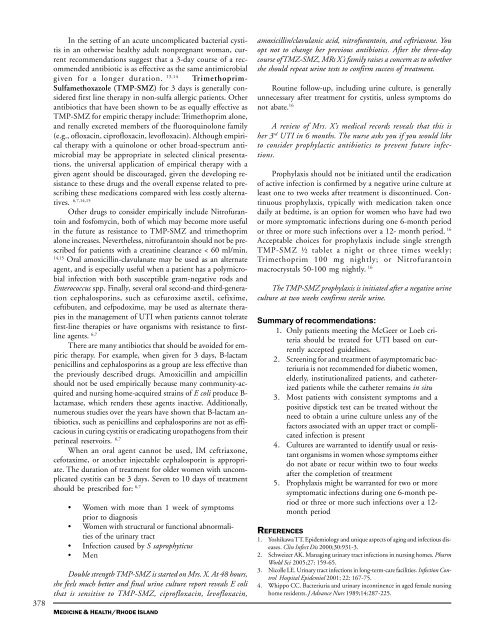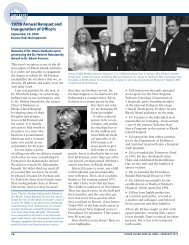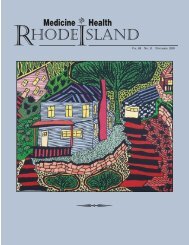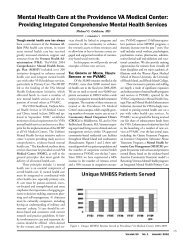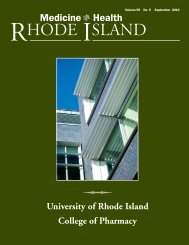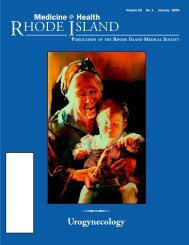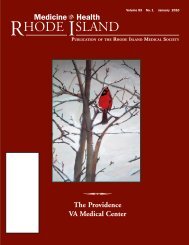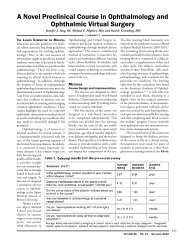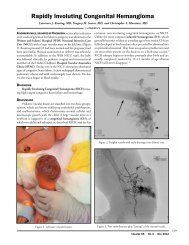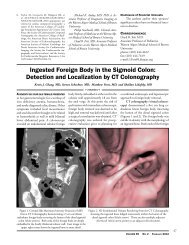Hyperuricemia & Gout - Rhode Island Medical Society
Hyperuricemia & Gout - Rhode Island Medical Society
Hyperuricemia & Gout - Rhode Island Medical Society
Create successful ePaper yourself
Turn your PDF publications into a flip-book with our unique Google optimized e-Paper software.
378<br />
In the setting of an acute uncomplicated bacterial cystitis<br />
in an otherwise healthy adult nonpregnant woman, current<br />
recommendations suggest that a 3-day course of a recommended<br />
antibiotic is as effective as the same antimicrobial<br />
given for a longer duration. 13,14 Trimethoprim-<br />
Sulfamethoxazole (TMP-SMZ) for 3 days is generally considered<br />
first line therapy in non-sulfa allergic patients. Other<br />
antibiotics that have been shown to be as equally effective as<br />
TMP-SMZ for empiric therapy include: Trimethoprim alone,<br />
and renally excreted members of the fluoroquinolone family<br />
(e.g., ofloxacin, ciprofloxacin, levofloxacin). Although empirical<br />
therapy with a quinolone or other broad-spectrum antimicrobial<br />
may be appropriate in selected clinical presentations,<br />
the universal application of empirical therapy with a<br />
given agent should be discouraged, given the developing resistance<br />
to these drugs and the overall expense related to prescribing<br />
these medications compared with less costly alternatives.<br />
6,7,14,15<br />
Other drugs to consider empirically include Nitrofurantoin<br />
and fosfomycin, both of which may become more useful<br />
in the future as resistance to TMP-SMZ and trimethoprim<br />
alone increases. Nevertheless, nitrofurantoin should not be prescribed<br />
for patients with a creatinine clearance < 60 ml/min.<br />
14,15<br />
Oral amoxicillin-clavulanate may be used as an alternate<br />
agent, and is especially useful when a patient has a polymicrobial<br />
infection with both susceptible gram-negative rods and<br />
Enterococcus spp. Finally, several oral second-and third-generation<br />
cephalosporins, such as cefuroxime axetil, cefixime,<br />
ceftibuten, and cefpodoxime, may be used as alternate therapies<br />
in the management of UTI when patients cannot tolerate<br />
first-line therapies or have organisms with resistance to firstline<br />
agents. 6,7<br />
There are many antibiotics that should be avoided for empiric<br />
therapy. For example, when given for 3 days, B-lactam<br />
penicillins and cephalosporins as a group are less effective than<br />
the previously described drugs. Amoxicillin and ampicillin<br />
should not be used empirically because many community-acquired<br />
and nursing home-acquired strains of E coli produce B-<br />
lactamase, which renders these agents inactive. Additionally,<br />
numerous studies over the years have shown that B-lactam antibiotics,<br />
such as penicillins and cephalosporins are not as efficacious<br />
in curing cystitis or eradicating uropathogens from their<br />
perineal reservoirs. 6,7<br />
When an oral agent cannot be used, IM ceftriaxone,<br />
cefotaxime, or another injectable cephalosporin is appropriate.<br />
The duration of treatment for older women with uncomplicated<br />
cystitis can be 3 days. Seven to 10 days of treatment<br />
should be prescribed for: 6,7<br />
• Women with more than 1 week of symptoms<br />
prior to diagnosis<br />
• Women with structural or functional abnormalities<br />
of the urinary tract<br />
• Infection caused by S saprophyticus<br />
• Men<br />
Double strength TMP-SMZ is started on Mrs. X. At 48 hours,<br />
she feels much better and final urine culture report reveals E coli<br />
that is sensitive to TMP-SMZ, ciprofloxacin, levofloxacin,<br />
MEDICINE & HEALTH/RHODE ISLAND<br />
amoxicillin/clavulanic acid, nitrofurantoin, and ceftriaxone. You<br />
opt not to change her previous antibiotics. After the three-day<br />
course of TMZ-SMZ, MRs X’s family raises a concern as to whether<br />
she should repeat urine tests to confirm success of treatment.<br />
Routine follow-up, including urine culture, is generally<br />
unnecessary after treatment for cystitis, unless symptoms do<br />
not abate. 16<br />
A review of Mrs. X’s medical records reveals that this is<br />
her 3 rd UTI in 6 months. The nurse asks you if you would like<br />
to consider prophylactic antibiotics to prevent future infections.<br />
Prophylaxis should not be initiated until the eradication<br />
of active infection is confirmed by a negative urine culture at<br />
least one to two weeks after treatment is discontinued. Continuous<br />
prophylaxis, typically with medication taken once<br />
daily at bedtime, is an option for women who have had two<br />
or more symptomatic infections during one 6-month period<br />
or three or more such infections over a 12- month period. 16<br />
Acceptable choices for prophylaxis include single strength<br />
TMP-SMZ ½ tablet a night or three times weekly;<br />
Trimethoprim 100 mg nightly; or Nitrofurantoin<br />
macrocrystals 50-100 mg nightly. 16<br />
The TMP-SMZ prophylaxis is initiated after a negative urine<br />
culture at two weeks confirms sterile urine.<br />
Summary of recommendations:<br />
1. Only patients meeting the McGeer or Loeb criteria<br />
should be treated for UTI based on currently<br />
accepted guidelines.<br />
2. Screening for and treatment of asymptomatic bacteriuria<br />
is not recommended for diabetic women,<br />
elderly, institutionalized patients, and catheterized<br />
patients while the catheter remains in situ<br />
3. Most patients with consistent symptoms and a<br />
positive dipstick test can be treated without the<br />
need to obtain a urine culture unless any of the<br />
factors associated with an upper tract or complicated<br />
infection is present<br />
4. Cultures are warranted to identify usual or resistant<br />
organisms in women whose symptoms either<br />
do not abate or recur within two to four weeks<br />
after the completion of treatment<br />
5. Prophylaxis might be warranted for two or more<br />
symptomatic infections during one 6-month period<br />
or three or more such infections over a 12-<br />
month period<br />
REFERENCES<br />
1. Yoshikawa TT. Epidemiology and unique aspects of aging and infectious diseases.<br />
Clin Infect Dis 2000;30:931-3.<br />
2. Schweizer AK. Managing urinary tract infections in nursing homes. Pharm<br />
World Sci 2005;27: 159-65.<br />
3. Nicolle LE. Urinary tract infections in long-term-care facilities. Infection Control<br />
Hospital Epidemiol 2001; 22: 167-75.<br />
4. Whippo CC. Bacteriuria and urinary incontinence in aged female nursing<br />
home residents. J Advance Nurs 1989;14:287-225.


